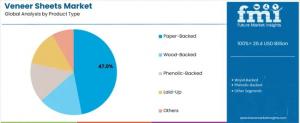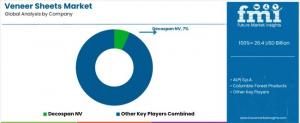Global and European Veneer Sheets Market Outlook 2025 to 2035
The veneer sheets market is projected to grow from USD 26.4 billion in 2025 to USD 38.0 billion by 2035, at a CAGR of 3.7%
NEWARK, DE, UNITED STATES, November 18, 2025 /EINPresswire.com/ -- The global veneer sheets market is entering a decade of steady, sustainability-led expansion, with new research forecasting its value to rise from USD 26.4 billion in 2025 to USD 38 billion by 2035, marking a 46.6% total growth and a CAGR of 3.7%. According to Future Market Insights (FMI), this growth is anchored by accelerating commercial construction, expanding furniture manufacturing output, and rising global emphasis on certified, low-emission interior materials.
Market Growth Accelerates as Sustainable Design Takes Center Stage
Between 2025 and 2030, the veneer sheets market is projected to grow from USD 26.4 billion to USD 31.8 billion, representing 43.9% of the decade’s total expansion. By 2035, the market is expected to add another USD 6.9 billion, with engineered veneers, advanced surface treatments, and sustainable wood sourcing taking precedence in both commercial and residential applications.
Demand is particularly strong for paper-backed veneer sheets, which hold an estimated 47.0% global market share in 2025, driven by their flexibility, processing efficiency, and compatibility with modern adhesive systems.
Subscribe for Year-Round Insights → Stay ahead with quarterly and annual data updates: https://www.futuremarketinsights.com/reports/sample/rep-gb-4152
Commercial Sector Remains the Dominant Demand Driver
In 2025, the commercial segment accounts for 58.0% of global veneer sheet consumption, led by:
- Office interiors – 24%
- Hospitality – 18%
- Retail – 12%
- Institutional facilities – 4%
Global renovation cycles, corporate space optimization, and green building requirements are accelerating demand for veneer sheets that offer fire-rated performance, low-VOC emissions, and rapid-installation features.
Hardwood Veneers Maintain Their Premium Position
The hardwood category leads with a 56.0% share in 2025, reflecting widespread preference for high-value species such as oak, walnut, maple, and cherry in luxury interiors and high-end architectural millwork. Engineered and reconstituted veneers follow with 20.0%, supported by sustainability-oriented manufacturing advancements.
Regional Performance Highlights: APAC, Europe, USA & Saudi Arabia Lead Global Momentum
APAC: The Fastest-Growing Regional Market
Asia Pacific continues to outperform all global regions, led by India (4.6% CAGR), China (4.3%), South Korea (3.8%), and Japan (3.4%). Growth stems from expanding commercial fit-outs, advanced furniture manufacturing, rising premium housing developments, and surging demand for FSC-certified and low-VOC veneer products.
India emerges as the world’s fastest-growing market, driven by rapid urbanization, commercial interior investments, and an expanding organized furniture sector.
Europe: Design-Led Manufacturing Strengthens Market Demand
The European market is set to increase from USD 7.4 billion in 2025 to USD 10.2 billion by 2035, posting a 3.3% CAGR. Key regional contributors include:
- Germany – 22% market share
- Italy – 16%
- France – 14%
- United Kingdom – 12%
Advanced modular furniture manufacturing, premium kitchen production, and stringent EN/CE certification requirements reinforce Europe’s strong veneer adoption rate.
USA: Remodeling and Engineered Veneer Innovation Drive Growth
The United States is forecast to expand at 3.5% CAGR, supported by high-end residential renovation, growth in architectural panel production, and expanding demand for sustainable wood products in commercial interiors. The mature U.S. construction and millwork ecosystem continues to preference engineered, low-emission, and premium hardwood veneers.
Saudi Arabia & Middle East: Construction Boom Boosts Market
Saudi Arabia’s escalating commercial mega-projects, hospitality developments, and luxury residential expansions are boosting adoption of high-performance veneer sheets. Market traction is reinforced by GCC-level building standards, rising preference for natural materials, and rapid penetration of pre-finished veneer systems across architectural applications.
Gain complete access to the report for extensive coverage of market forecasts, competitive benchmarking, and evolving industry trends! https://www.futuremarketinsights.com/checkout/4152
Key Trends Transforming Market Dynamics
1. Rise of Pre-Finished and Performance-Enhanced Veneers
Manufacturers are scaling deployment of UV-cured topcoats, scratch-resistant layers, and antimicrobial finishes, enabling faster installation and enhanced durability—critical for high-traffic commercial environments.
2. Sustainability and Chain-of-Custody Verification
FSC and PEFC certifications are rapidly becoming standard requirements for procurement teams, architects, and millwork firms. Enhanced traceability is enabling manufacturers to secure premium positioning in specification-led markets.
3. Engineered Veneer Advancements
Reconstituted veneers utilizing fast-growing plantation species are gaining traction due to their consistent patterns, reduced waste, and exotic-species replication capabilities, supporting circular economy objectives.
Competitive Landscape: Global Brands Increase Sustainability and Innovation Investments
Leading players include Decospan NV, ALPI S.p.A., Columbia Forest Products, FormWood Industries, Oakwood Veneer Company, Flexible Materials Inc., Greenlam Industries (Decowood), Timber Products Company, Fritz Kohl GmbH & Co. KG, and Sauers & Company Veneers.
- Decospan NV holds the largest global share at 6.5%, driven by its Shinnoki line of pre-finished veneers.
- ALPI S.p.A. continues expanding its ALPIkord series with chain-of-custody enhancements.
- Columbia Forest Products is strengthening its PureBond portfolio for low-emission cabinetry and millwork.
Manufacturers worldwide are investing in advanced finishing lines, engineered veneer production technology, and sustainable sourcing systems to future-proof competitiveness.
Future Outlook: What’s Next for the Veneer Sheets Market?
From 2025 to 2035, veneer sheets will remain central to sustainable architectural design and high-performance furniture production. Market growth will be supported by:
- Rising commercial renovation cycles across APAC, Europe, USA, and the Middle East.
- Increasing corporate adoption of FSC-certified and low-VOC materials.
- Expanding engineered veneer capabilities and reconstituted wood technologies.
- Greater emphasis on design versatility, lightweight construction, and efficient material utilization.
As building codes tighten and sustainability mandates strengthen, veneer sheets will continue to gain importance as low-emission, aesthetically authentic, and installation-efficient wood surfacing materials.
Exploring Insights Across Emerging Global Markets:
North America Potassium Formate Market: https://www.futuremarketinsights.com/reports/north-america-potassium-formate-market
Reclaimed Rubber Market: https://www.futuremarketinsights.com/reports/reclaimed-rubber-market
Barium Sulfate Market: https://www.futuremarketinsights.com/reports/barium-sulphate-market
Acetyls Market: https://www.futuremarketinsights.com/reports/acetyls-market
Adipic Acid Market: https://www.futuremarketinsights.com/reports/adipic-acid-market
About Future Market Insights (FMI)
Future Market Insights, Inc. (FMI) is an ESOMAR-certified, ISO 9001:2015 market research and consulting organization, trusted by Fortune 500 clients and global enterprises. With operations in the U.S., UK, India, and Dubai, FMI provides data-backed insights and strategic intelligence across 30+ industries and 1200 markets worldwide.
Why Choose FMI: Empowering Decisions that Drive Real-World Outcomes: https://www.futuremarketinsights.com/why-fmi
Sudip Saha
Future Market Insights Inc.
+18455795705 ext.
email us here
Legal Disclaimer:
EIN Presswire provides this news content "as is" without warranty of any kind. We do not accept any responsibility or liability for the accuracy, content, images, videos, licenses, completeness, legality, or reliability of the information contained in this article. If you have any complaints or copyright issues related to this article, kindly contact the author above.


